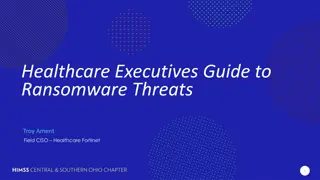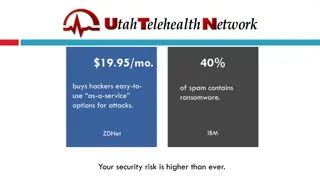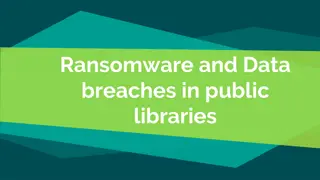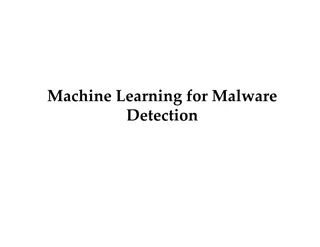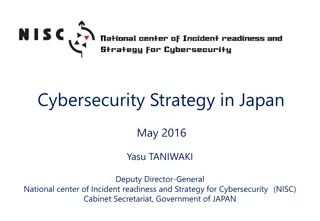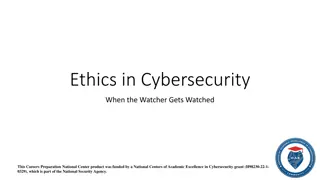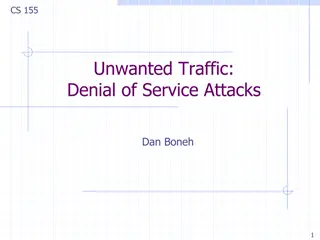
Cybersecurity Solutions to Protect Against Ransomware Attacks
Discover effective strategies and tools to protect your business from ransomware attacks. Stay secure and informed.n
Download Presentation

Please find below an Image/Link to download the presentation.
The content on the website is provided AS IS for your information and personal use only. It may not be sold, licensed, or shared on other websites without obtaining consent from the author. Download presentation by click this link. If you encounter any issues during the download, it is possible that the publisher has removed the file from their server.
E N D
Presentation Transcript
Cybersecurity Solutions to Protect Against Ransomware Attacks In recent years, ransomware attacks have emerged as one of the most formidable threats in the realm of cybersecurity. These malicious attacks involve encrypting a victim's data and demanding a ransom for its release, causing significant financial and operational damage to organizations. To mitigate these risks, businesses must adopt comprehensive cybersecurity solutions designed to protect against ransomware. What is Ransomware? Ransomware is a type of malicious software that encrypts the files on a victim's device or network, rendering them inaccessible. The attacker then demands a ransom, typically in cryptocurrency, in exchange for the decryption key. Ransomware can spread through various vectors, including: Phishing emails
Malicious downloads Vulnerabilities in software The consequences can be devastating, which is why it is paramount to collaborate with a credible cybersecurity service provider to decrease the likelihood of all risks associated with a ransomware attack. Organizations may face: Financial Losses: Ransom payments can be substantial, and there are additional costs associated with downtime, data recovery, and reputational damage. Operational Disruption: Encrypted data can halt business operations, leading to lost productivity and revenue. Data Loss: Even if the ransom is paid, there is no guarantee that the data will be restored or that the attacker will not retain a copy. Read More Article: John James Audubon: The Visionary Behind 'The Birds of America' Cybersecurity Solutions to Protect Against Ransomware To protect against ransomware, you must implement a multi-layered approach to cybersecurity. Here are some key solutions and best practices: 1. Endpoint Protection Endpoints, such as computers and mobile devices, are common entry points for ransomware. Executing robust endpoint protection solutions is critical and they typically include: Antivirus and Anti-malware Software: Regularly updated software can detect and block ransomware before it can execute. Behavioral Analysis: Advanced endpoint protection platforms use machine learning to identify and stop suspicious behavior indicative of ransomware.
Endpoint Detection and Response (EDR): EDR solutions provide continuous monitoring and response capabilities to quickly identify and address threats. 2. Network Security According to Cybersecurity Services Toronto, network security measures can prevent ransomware from spreading within an organization. For example, firewalls can: Block malicious traffic Prevent unauthorized access to the network Similarly, IDPS can detect and block suspicious activities and potential threats. Dividing the network into smaller segments can limit the spread of ransomware if an infection occurs. 3. Regular Backups By maintaining up-to-date copies of critical data, you can restore your system without paying the ransom. You should conduct regular backups to ensure recent data can be recovered and store backups offline or in a separate network to protect them from being encrypted by ransomware. In addition, make sure you regularly test backup restorations to ensure data can be successfully recovered. 4. User Training and Awareness Look for a professional specializing in cybersecurity consulting Toronto to educate employees about cybersecurity best practices. Training should cover: Phishing Awareness: Teach employees how to recognize and report phishing emails. Safe Browsing Practices: Encourage safe internet browsing habits to avoid malicious websites. Incident Reporting: Ensure employees know how to report suspicious activities or potential security incidents.
5. Patch Management Vulnerabilities in software can be exploited by ransomware to gain access to systems. Cybersecurity service providers suggest keeping all software, including operating systems and applications, up to date with the latest security patches. Use automated tools to manage and deploy patches across the organization. 6. Email Security Strong email security measures act as one of the best cybersecurity solutions. Key strategies include: Email Filtering: Use advanced email filtering solutions to block spam and malicious emails. Attachment Scanning: Scan email attachments for malware before they reach the recipient. 7. Incident Response Plan Having a well-defined incident response plan is essential for minimizing the impact of a ransomware attack. The plan should include: Preparation: Establish roles and responsibilities for incident response. Detection and Analysis: Define procedures for detecting and analyzing security incidents. Containment and Eradication: Develop strategies for containing and eliminating ransomware. Recovery: Outline steps for restoring systems and data. Post-Incident Review: Conduct a post-incident review to identify lessons learned and improve future response efforts. Ransomware Trends and Impacts Year Number of Attacks Estimated Costs (Billions)
2018 181.5 million $8.2 2019 205.5 million $11.5 2020 304.6 million $20.0 2021 493.3 million $29.1 2022 620.5 million $40.0 Read More Article: Why Is My Dryer Making Loud Noises? Solutions and Fixes What is The Role of Advanced Technologies? Artificial Intelligence and Machine Learning AI and machine learning significantly improve threat detection and response capabilities by identifying patterns and anomalies associated with ransomware. These technologies utilize historical data for predictive analysis, helping to forecast and prevent potential ransomware attacks. Furthermore, they enable real-time monitoring of systems, continuously scanning for signs of ransomware and initiating automated responses when threats are detected. Zero Trust Architecture Zero trust architecture operates on the principle that threats can originate both inside and outside the network. This approach involves several key practices. Identity verification is continuously performed to ensure the legitimacy of users and devices before granting access. Least privilege access is enforced, restricting users to only the resources necessary for their roles, thereby minimizing the potential damage from compromised accounts. Additionally, micro-segmentation is employed to create isolated network segments, effectively containing the spread of ransomware if an infection occurs.
The Bottom Line Ransomware attacks pose a significant threat to organizations of all sizes. By focusing on a comprehensive cybersecurity strategy and leveraging advanced technologies, you can significantly reduce their risk of falling victim to ransomware. Proactive measures and continuous vigilance are essential in safeguarding against the ever-evolving threat of ransomware. Looking for the best cybersecurity service provider to protect your company s data and assets? We have got you covered! At IT-Solutions.CA, we have years of experience and extensive knowledge in planning effective cybersecurity plans and techniques. So, get in touch with our team and let us assist you! Site Article: Cybersecurity Solutions to Protect Against Ransomware Attacks



